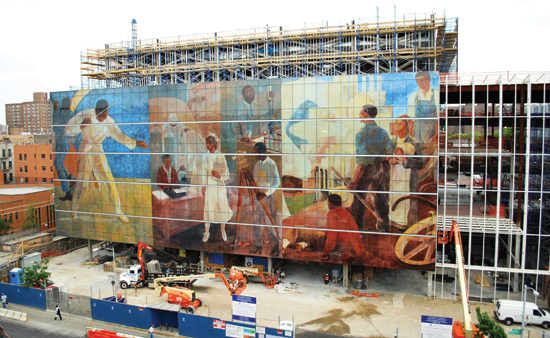More Than One Way to Skin a Building
2 Harlem Hospital Patient Pavilion
Making a Statement
Project Credits
Location: 506 Lenox Avenue, New York, NY
Owner: NYC Health & Hospitals Corporation, New York, NY
Developer: Dormitory Authority of the State of New York (DASNY)
Architect: HOK, New York, NY
Associate Architect: Studio JTA, Bronx, NY
Structural Engineers: Robert Silman & Associates, New York, NY
Trevor Salmon Associates, New York, NY
Mechanical Engineers: Kallen & Lemelson, New York, NY
Lakhani & Jordan, New York, NY
Construction Manager: TDX Construction Corporation, New York, NY
Curtain Wall Consultant: Ove Arup & Partners, New York, NY
Structural Steel Erector: Brooklyn Welding Corporation, Brooklyn, NY
Miscellaneous Iron Erector: Capco Steel Co., Providence, RI
Architectural Metal Erector: Brooklyn Welding Corporation, Brooklyn, NY
Curtain Wall Erector: W&W Glass Systems/Metal Sales, Nanuet, NY
Metal Deck Erector: AC Associates, Lyndhurst, NJ
The new patient pavilion at Harlem Hospital is proving that modernization need not be at the expense of historical significance.
Design Program–Create a Unified, Modernized Complex
The modernization of this 100-plus-year-old teaching hospital was needed to make room for improved patient care and community outreach in the Harlem section of New York City. The recently completed project will house new emergency and surgery departments, diagnostic and treatment services, a critical care suite, and a modern radiology center—all centered around an expansive full-height atrium to create a unified health care complex out of seven disparate structures spread over two city blocks.
Design Approach–A Unifying Facade
The project's design, undertaken by HOK's New York office in association with Bronx-based architect Jack Travis of Studio/JTA called for constructing a new six-story, 150,000-square-foot pavilion to connect to the existing Martin Luther King Pavilion and the existing Ron Brown Ambulatory Care Pavilion. Though the plan is rooted in bringing the most up-to-date medical care and teaching facilities to Harlem, at its creative center is the restoration of the hospital's historic WPA-era murals painted by some of the most famous African American artists of the 1930s, including Charles Alston and Vertis Hayes. While the original artwork, depicting themes of medical science, life in Harlem, and experiences of black people in America, will be displayed in the new pavilion's lobby gallery, Hayes's work Pursuit of Happiness is replicated on the building's six-story curtain wall facade in the form of a 180-by-65-foot glass mural mounted on a concealed steel structure.
 |
The curtain wall facade on the Harlem Hospital New Patient Pavilion features a digitally applied artistic mural that provides light control while still allowing vision out. Photo by Dominick Reda/TDX Construction Corp., courtesy of the Ornamental Metal Institute of New York |
Structural System Coordination
The unusual project posed several challenges to the design team, who worked with structural engineer Robert Silman & Associates to realize the new pavilion's structural design. Pavilion spaces needed to be organized to flow into existing portions of the hospital campus. Perhaps most importantly, the design had to anticipate plans to build two additional floors atop the new pavilion in the future. Using steel for the structural frame provided the necessary flexibility in both cases, but the team found that the unique mural curtain wall design approach prevented them from using more efficient cross-braced frames to address lateral loading. Therefore, the building's lateral system (with the exception of a double-height mechanical space) is designed as a series of moment frames. This required large W14 x 342 and W24 x 117 girders, both of Grade 50, A992 steel, to keep lateral drift to acceptable limits. The double-height mechanical space at the seventh floor created a “soft story” where moment frames were inefficient, so the design team instead used perimeter-braced framing for better lateral load resistance.









